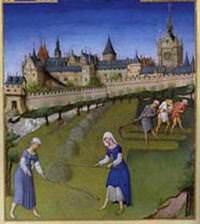The Prudent Village: Risk Pooling Institutions in Medieval English Agriculture
By Gary Richardson
The Journal of Economic History, Volume 65 , Issue 2 (2005)
Abstract: The prudent peasant mitigated the risk of crop failures by scattering his arable land throughout his village, Deirdre McCloskey argued, because alternative risk- sharing institutions did not exist. But, alternatives did exist, this essay con- cludes. Medieval English peasants formed two types of farmers’ cooperatives. Fraternities protected members from the perils of everyday life. Customary poor laws redistributed resources towards villagers beset by bad luck. In both institutions, the expectation of reciprocation motivated farmers with surpluses to aid neighbors with shortages.
Introduction: Deirdre McCloskey’s theory of the prudent peasant has three tenets. Scattering farm fields reduced the variance of crop yields and thus the risk of starvation. Scattering farm fields reduced average crop yields and thus peasants’ incomes. Scattering farm fields was the only way in which medieval English peasants mitigated risk. Translating the tenets into terms of portfolio theory forms the foundation of McCloskey’s model. The risk to each farmer as measured by the variance of total out-put was reduced by diversifying holdings among many small plots fac- ing different weather, weed, water, rodent, insect, and soil conditions. If one plot did poorly and another did well, a farmer could still harvest enough grain to survive from all of his plots put together. However, diversification was expensive. Scattered holdings yielded 10 percent less grain than their consolidated counterparts. So, scattering entailed an exchange of return for risk. The prudent peasant chose to scatter his farm fields to protect himself and his family from idiosyncratic agricultural shocks because better alternatives did not exist. Peasants had no better way of protecting themselves from idiosyncratic agricultural shocks. Peasants lacked access to cheap relief. Medieval men and women, for example, neither practiced charity nor pooled risk
McCloskey’s conclusion piqued Miles Kimball’s curiosity. Modern insurance institutions may not have existed, but what about informal arrangements? A system of consumption loans among farmers could have performed some or all of the functions that formal institutions failed to perform. Those arrangements could have arisen in the guise of the extended family, a fraternal order, or a group of fast friends. Kimball labeled all such arrangements “farmers’ cooperatives,” and modeled those cooperatives as repeated games. Kimball calibrated the models with McCloskey’s data on medieval crop yields and demonstrated that farmers’ cooperatives should have existed in medieval English villages.
The Prudent Village: Risk Pooling Institutions in Medieval English Agriculture
By Gary Richardson
The Journal of Economic History, Volume 65 , Issue 2 (2005)
Abstract: The prudent peasant mitigated the risk of crop failures by scattering his arable land throughout his village, Deirdre McCloskey argued, because alternative risk- sharing institutions did not exist. But, alternatives did exist, this essay con- cludes. Medieval English peasants formed two types of farmers’ cooperatives. Fraternities protected members from the perils of everyday life. Customary poor laws redistributed resources towards villagers beset by bad luck. In both institutions, the expectation of reciprocation motivated farmers with surpluses to aid neighbors with shortages.
Introduction: Deirdre McCloskey’s theory of the prudent peasant has three tenets. Scattering farm fields reduced the variance of crop yields and thus the risk of starvation. Scattering farm fields reduced average crop yields and thus peasants’ incomes. Scattering farm fields was the only way in which medieval English peasants mitigated risk. Translating the tenets into terms of portfolio theory forms the foundation of McCloskey’s model. The risk to each farmer as measured by the variance of total out-put was reduced by diversifying holdings among many small plots fac- ing different weather, weed, water, rodent, insect, and soil conditions. If one plot did poorly and another did well, a farmer could still harvest enough grain to survive from all of his plots put together. However, diversification was expensive. Scattered holdings yielded 10 percent less grain than their consolidated counterparts. So, scattering entailed an exchange of return for risk. The prudent peasant chose to scatter his farm fields to protect himself and his family from idiosyncratic agricultural shocks because better alternatives did not exist. Peasants had no better way of protecting themselves from idiosyncratic agricultural shocks. Peasants lacked access to cheap relief. Medieval men and women, for example, neither practiced charity nor pooled risk
Click here to read this article from the University of California, Irvine
Subscribe to Medievalverse
Related Posts